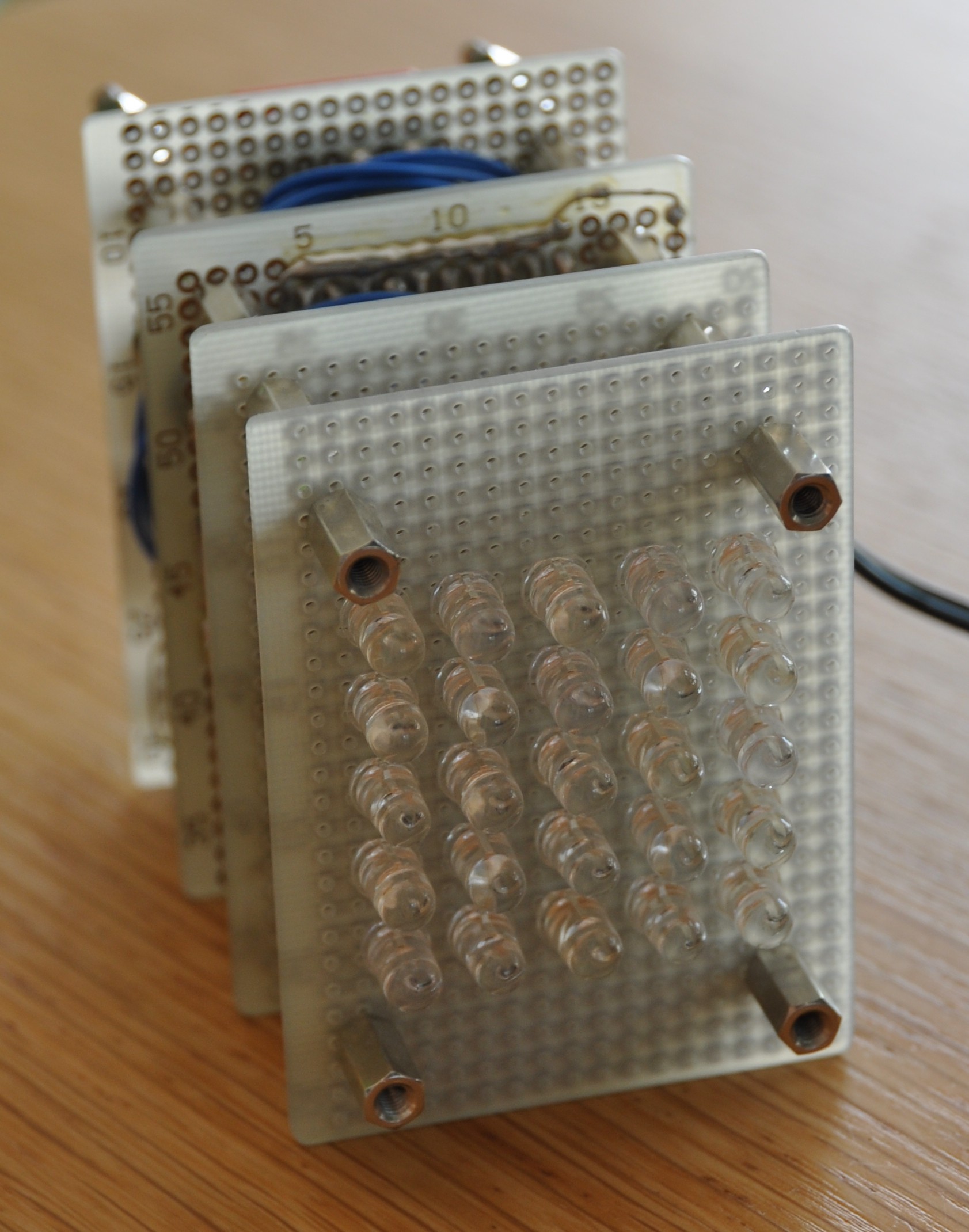Which colours are LEDs sensitive to ?
LEDs are nice for illumination, and sometimes, LEDs are used as a colour sensor. But I wished to use a handful of LEDs as a spectral sensor with more channels than just red, green blue...
So I soldered 14 different visible LEDs, two infrared LEDs and two photodiodes to a microcontroller board, using the same measurement principle as in https://hackaday.io/project/19244-leds-as-photodiodes-for-1-kb-challenge
Basically, every LED is connected with both anode and cathode to GPIO pins, anode is set low, cathode is set high, and then cathode is switched to input. Photo current discharges the junction (and wire) capacitance, and the time until the cathode input pin toggles is measured.

Channel list (1 to 6 are normal brightness tinted LEDs, 11 to 18 clear high brightness LEDs):
01 Red
02 Red
03 Yellow
04 Green
05 Blue
06 Blue
07 IR 880 nm SFH485
08 IR 940 nm
09 Photodiode
10 Photodiode BPW34
11 Darkred EPD-660-3-0.9
12 Red EPD-630-394
13 Red
14 Yellow
15 Red
16 Yellow-Green
17 Green
18 Blue
Here are their forward voltages, measured with a constant current of 4.2 mA, sorted for ascending voltage:
(10) 0.63 V Infrared Si photodiode BPW34
(09) 0.65 V Infrared Si photodiode
(08) 1.08 V Infrared from an old TV remote control
(07) 1.22 V Infrared SFH485
(11) 1.55 V Barely visible very dark red EPD-660-3-0.9
(15) 1.68 V Red
(01) 1.72 V Red
(12) 1.75 V Red EPD-630-394
(03) 1.85 V Yellow
(13) 1.87 V Red
(02) 1.89 V Red
(14) 1.90 V Yellow
(16) 1.92 V Yellowish-Green
(04) 1.92 V Green
(18) 2.68 V Blue
(17) 2.70 V Green
(05) 2.76 V Blue
(06) 3.17 V Blue
Error of forward voltage measurement should be in the +- 0.03V range.
My assumption was that the LEDs with direct bandgap semiconductor material would be roughly visible for their own emitted wavelength, and the indirect bandgap ones would be sensitive to wavelengths slightly shorter than their own emission.
With a nice spectrometer available in laser spectroscopy lab at university, I measured the emission spectra:




Note that the spectrometer is configured for Raman spectroscopy with a 473 nm laser, therefore, it is equipped with a lowpass interference filter, which cuts off wavelengths shorter than about 482 nm. The blue LEDs spectra are clipped for this reason.
For a first small test to confirm the wavelengths the LEDs might be sensitive to, I took my decorative LED lamp I build many years ago which contains red, yellow, green, blue and ultraviolet LEDs. With this, I illuminated all the sensor channels and took notes which is sensitive to which colour.

I was very surprised, but observations first:
Red illumination: Reaction on channels 1 | 7 8 | 9 10 | 11 12 13 14 15 | 18. Yellow illumination: Reaction on channels 3 4 | 7 8 | 9 10 | 11 12 13 14 15 | 16 18. Green illumination: Reaction on channels 3 4 | 7 8 | 9 10 | 11 12 13 14 15 | 16 17 18. Blue illumination: Reaction on channels 3 4 5 | 7 8 | 9 10 | 11 12 13 14 15 | 16 17 18. UV illumination: Reaction on channels 2 3 4 5 6 | 7 8 | 9 10 | 11 12 13 14 15 | 16 17 18.
Note that the diffuse LEDs 1, 2, 5, and 6 had a much lower sensitivity than the other ones. I took a quite long discharge time in order to see if there is any sensitivity.
Surprises:
* The tint of "01 Red" must act as a narrow filter, so 01 is sensitive to the red illumination only.
* "02 Red" is sensitive to ultraviolet only despite being a red LED.
* "18 Blue" is slightly sensitive to everything, despite being a blue LED.
Clearly, my former rule of thumb that a LED is sensitive for its own wavelength or slightly shorter (more blueish) does not hold in all cases. Therefore, I cannot easily determine the LED sensitivity by measuring its emission spectrum. I need a tunable monochromatic source of light for measuring the actual sensitivity spectrum of the LEDs. Unfortunately, I could not take apart the expensive spectrometer in university lab..
Finally, I found a surplus grating monochromator with manual mechanics giving...
Read more » Matthias Koch
Matthias Koch
 BPW34 is the same photodiode as in the first run of the experiment, which is sensitive to the complete...
BPW34 is the same photodiode as in the first run of the experiment, which is sensitive to the complete...

 Jercio-sk6812
Jercio-sk6812

 Alex Camilo
Alex Camilo
Interesting results. Nice work, and good job cobbling together the test instruments for this.